Find Out if the Plane is a Continuing Flight Number or Not
In aviation, there's a meaning behind everything.
BA170, AS412, UA3543, DL8869 – all are numbers assigned to flights.
The flight number listed on your boarding pass may seem random, but airlines have developed clever systems to numerically sort the hundreds or thousands of flights they operate each day.
The basics
A flight number is a specific code that an airline assigns to a particular flight in its network. In addition to its use for airlines, the number helps Air Traffic Control organize and track flights in the air.
There are a few standardized rules when it comes to numbering flights.
For flights operating at the same time, numbers can't be repeated. Also, numbers must not exceed four digits.
With a few exceptions, flights are usually numbered based on their direction of travel. For example, north and eastbound flights are assigned even numbers, while south and westbound flights are numbered odd.
To the left of a flight number is a two-character code identifying the airline. All commercial airlines have a unique identifier code assigned to them by the International Air Transport Association.
For most airlines, the code serves as a short abbreviation for the company's full name. For example, American Airlines uses "AA" and United Airlines uses "UA."
Not all codes appear to be synonymous with an airline, though. Southwest Airlines, for example, uses the identifier "WN" because "SW" is already taken by Air Namibia in Africa. When JetBlue was founded in 2000, "JB" was already being used by Helijet International. JetBlue selected "B6" as it was the sixth available number with the letter B prefix.
Managing all the numbers
Depending on their size, airlines operate up to 1,000 flights in a single day. With so many flights operating within that span, there is a limit on the number of flight numbers available for use. This has forced airlines to find ways to save numbers.
Airlines use a combination of automatic and manual models to help organize which numbers are in use and which ones are available. These models are particularly helpful when an airline adds a new route.
One way to save on numbers is to use them for both an inbound and outbound flight. Delta Air Lines is well-known for using this method for its flights out of the carrier's Atlanta hub. Flight DL318, for example, operates the outbound flight from Atlanta to Myrtle Beach, and the turn back to Atlanta remains as Flight 318 despite being a separate flight.
Another routine practice is to simply raise or lower a flight number's digit by one. JetBlue operates flight B61685 from Boston to Pittsburgh. For the return back to Boston, the flight number is increased by one – B61686.

Airlines sometimes reserve special flight numbers for high profile routes – most notably the number 1. American Airlines, for example, operates its signature flight AA1 between New York- JFK and Los Angeles on a premium-configured Airbus A321. American has flown between the two cities since 1939.
Additionally, British Airways operated flight BA1 from New York-JFK to London-Heathrow when the airline flew the Concorde. Today, BA1 is still used to JFK, but on an all-business class A318 from London City Airport. United Airlines also operates flight UA1 between San Francisco and Singapore – the longest nonstop flight in the airline's network.
The inclusion of regional carriers forces some airlines to segregate number ranges for mainline and express flights. For example, American mainline flights vary from 1 to 2949, while regional flights range from 2950 to 6099. Regional numbers are then broken down into blocks by the operator. Republic Airways, one of several regional affiliates for American, numbers its flights from 4300 to 4699.
The lowest block numbers like 8000 and 9000 are usually assigned to ferry flights – empty flights with the purpose of repositioning an aircraft to another airport. Airplanes are assigned timetables which determine where they need to be throughout the day. In the event of a disruption such as a weather cancellation, a ferry flight may be required to get a plane to its final destination in order to satisfy the next day's schedule. Charters, such as flights for sports teams, are also assigned within this number range.
Sometimes airlines decide to get creative with flight numbers assigned to specific routes. For example, Alaska Airlines operates Flight AS412 from Seattle to Pittsburgh – a nod to the Steel City's area code.
Airlines will also arrange their flight numbers to act as a symbol that has an attachment to a city. For example, Alaska, Delta and United operate flight 500 to or from Indianapolis in recognition of the Indianapolis 500, the world's oldest auto race.
Other examples include American flight AA1776 between Boston and Philadelphia (the year of the Declaration of Independence) and American flight AA777 from Phoenix to Las Vegas (lucky sevens, anyone?).
Source: https://blueskypit.com/2020/03/09/deciphering-the-digits-in-your-flight-number/
Post a Comment for "Find Out if the Plane is a Continuing Flight Number or Not"